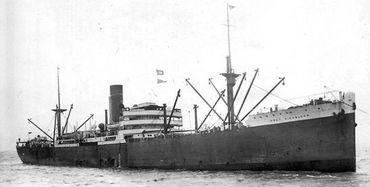
A Portland, Maine-based company is hoping to retrieve at least one box of platinum ingots from a World War II shipwreck off Cape Cod — and thereby salvage its own operation.
Greg Brooks, co-founder and principal of Sub Sea Research LLC, believes that 1.7 million ounces of platinum ingots worth an estimated $3 billion is still with the Port Nicholson, a steam-powered 481-foot British freighter that reportedly sank 50 miles northeast of Provincetown after being torpedoed June 16, 1942.
Research of period documents as well as interviews with survivors, relatives of the crew and a German U-boat captain prove beyond a doubt that the platinum is there along with a possible $165 million in other precious metals, Brooks said.
"If this was a murder trial, the guy would hang," he said in a phone interview Tuesday.
Investors bankrolled the recovery operation back in 2010 with $6 million in shares. Brooks purchased and outfitted a 214-foot vessel and paid $500,000 for a Vector M5 remote operating vehicle from Deep Ocean Engineering of San Jose, Calif., to explore the wreck, he said.
From the start, however, the Vector was not powerful enough to withstand the swift currents it encountered diving on the wreck 600 to 800 feet below. But in reviewing hundreds of hours of underwater video taken of the shipwreck, technicians saw around 30 boxes within the hole that had been blown in the cargo hold by one of the torpedoes and as well as spilling onto the ocean floor, Brooks said.
"We weren’t looking for boxes," Brooks said, but his subsequent research into a similar wreck revealed the very same boxes were used to ship gold ingots for lend-lease payments between the Soviet Union and the United States during World War II.
In the case of the Port Nicholson, Brooks said the ingots came from the Russian government as payment to the United States for aid during the war and that researchers found documentation that platinum had been shipped to the United States.
They also found paperwork that the U.S. Treasury was expecting 1.7 million ounces of ingots from Russia to be delivered by the Port Nicholson, he said.
Delays and funding issues have plagued the expedition, however. The Vector is an inspection class ROV, not meant to lift heavy objects, said Deep Ocean President Bob Sabo.
He corroborated Brooks’ story that the ROV experienced problems with its thrusters that left it underpowered. His company decided to retrofit these robotic vehicles with thrusters from a different manufacturer that he hopes will stabilize in swift ocean currents.
Brooks, who worked for 19 years installing pools in Maine, said he caught the treasure hunting bug when he found a silver ingot on a vacation dive in Haiti more than 20 years ago. He’s spent a lot of time and money seeking treasure, and finding some. But this project is his largest since he founded the company in 1994. With sea time averaging $35,000 a day on a treasure hunt that two years ago he thought would take a couple of weeks, the initial $6 million is quickly running out.
Brooks feels that if he can bring up some of the platinum that would encourage more investors.
"If we could raise a box. You start throwing gold and platinum ingots valued at $650,000 each, and that gets people’s attention," he said. But he needs $800,000 to go back out and do that, he said.
The new thrusters will be tested next week and Brooks thinks he has some investors who might be willing to fund another trip out to the Nicholson site.
"If I can get funding in place, I hope to be out there by the end of February, March first," he said.
The U.S. District Court in Portland ruled in 2009 that Brooks has an exclusive right to the site and its contents, although someone can lay claim after the treasure has been retrieved.
"If there is a legitimate claim, I can still get up to 90 percent of the value," he said.
The court, he said, tends to side with the party that has risked capital and their lives to recover the property.
"They’ll have to pry it from my cold, dead hands," Brooks said, laughing.